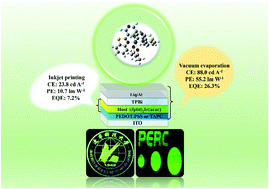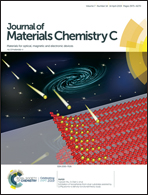Novel phosphorescent iridium(iii) emitters for both vacuum-deposition and inkjet-printing of OLEDs with exceptionally high efficiency†
Abstract
Two novel Ir(III) complexes, (fpbt)2Ir(acac) and (fpbm)2Ir(acac), containing the 2,6-difluoropyridine unit have been designed and synthesized. Both of them can be either vacuum deposited or inkjet printed as emitters to make OLEDs, because of their excellent solubility. They exhibited high thermostability and strong phosphorescent emission with a high quantum efficiency of 0.96 and 0.98. The vacuum-deposited phosphorescent OLEDs based on (fpbt)2Ir(acac) achieve 26.3% external quantum efficiency (EQE), 55.2 lm W−1 power efficiency (PE) and 88.0 cd A−1 current efficiency (CE), which are some of the highest values reported to date for such simple phosphorescent devices, without resorting to a state-of-the-art multilayer structure. The bilayer-inkjet-printed devices with the structure of ITO/PEDOT:PSS/CDBP:(fpbt)2Ir(acac)/TPBi/Liq/Al exhibit the CE of 23.8 cd A−1, PE of 10.7 lm W−1 and EQE of 7.2%, which are among the best reported for inkjet-printed OLEDs of similar structure. The result is considered to be a new milestone for multilayer-printed OLEDs. On the other hand, the spin-coated OLEDs only reach values of 17.9 cd A−1, 9.3 lm W−1 and 5.3%, which are not as good as those of the inkjet-printed devices. The reasons for such differences are investigated in detail.



 Please wait while we load your content...
Please wait while we load your content...